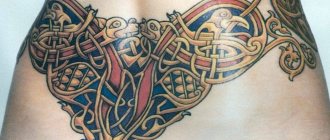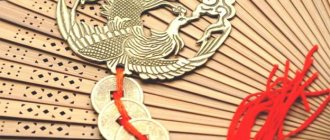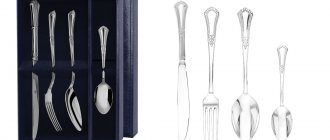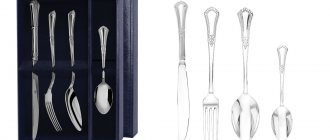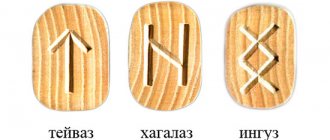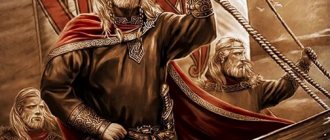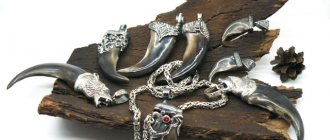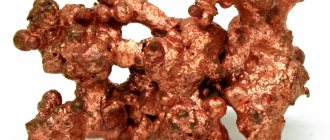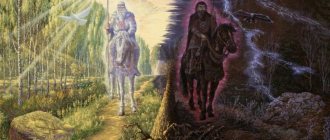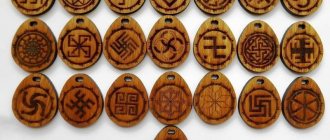The popularity of Vikings these days is easy to explain. Popular culture portrays them as brave, desperate and warlike people. We are attracted by the mysticism of runes, the romance of ancient sagas, and we are enchanted by the rhythmic lines of the Elder and Younger Eddas. Scandinavian symbols are inextricably linked with this entire layer of culture.
The Vikings series is a prime example of the portrayal of Scandinavians in pop culture.
In this article we will reveal the meaning of ancient northern amulets, tattoos and symbols, and also consider a modern symbol, the Scandinavian cross, with which the life of modern Vikings is somehow connected.
At the same time, we will try to dispel some of the misconceptions sown by popular culture and try to understand what the stern warriors really were like, what they believed in, what they worshiped. It will be interesting!
Worldview of the ancient Scandinavians
What does the average person know about the ancient tribes of the Scandinavians? These were Vikings, sailors and warriors. They believed in the aesir gods living in Asgard, at the top of the world tree Yggdrasil. Brave warriors who died in battle, according to their faith, ended up in Valhalla, and all the rest went to Hel. Actually this is not true.
The Eddas, from which all this is taken, reflect the beliefs of only one group of the Scandinavian population - those same Vikings - in the 9th-11th centuries. However, the words “Scandinavian” and “Viking” are not synonymous. Scandinavians are all the people living in Denmark, Sweden, Norway and Iceland. In the Viking Age, among them there were many ordinary people who did not at all strive to fall in battle. Among the gods, it was not the warlike Odin and Thor who were more revered, but, for example, the peace-loving Frey. So Scandinavian amulets are not only in the Eddas and sagas; a lot of interesting and, most importantly, reliable information can be found from ethnographers.
The word “Viking” essentially meant the same thing as “pirate” or “robber”.
Most of the Vikings were Scandinavians, but among them there were representatives of other Baltic peoples:
- Vendas, or Western Slavs;
- Curonians, ancestors of Lithuanians and Latvians;
- Estonians and other Finnish tribes.
Simple farmers, as well as feudal rulers, treated the Vikings without much warmth. Often they raised militias or hired some Vikings to deal with others. It is worth recalling the same “calling of the Varangians” from the history of Rus'.
Vikings could even be sent to the chopping block for jewelry, because these people were essentially considered pirates, and dealing with them was also regarded as a crime in many places.
The simple Scandinavians and representatives of other Germanic tribes had a worldview close to the Slavic or Celtic. These people believed that the world was created from the body of the giant Ymir, and therefore animated. They made sacrifices to good spirits and gods so that they would protect them from evil forces (trolls) and were afraid of black magic, the machinations of dark forces, from which they protected themselves with runes or protective patterns.
Also often purchased with this product
Catalog
About Us
Library
Question answer
Rune amulets
Charms
T-shirt Star Lada
We produce silver and gold products according to customer designs
Comments and reviews
Olga Ivanovna
(Zelenogorsk, Krasnoyarsk Territory) 2014-11-23 16:39:46
Good afternoon, dear masters! Is it possible to make a Brigid's Knot from gold so that the weight of the product does not exceed 5 grams? If yes, how much will it cost? Thank you for your answer, Olga Ivanovna
Rune workshop
2014-11-24 04:52:45
Hello. Made from 585-carat gold, such a product will cost 15,000 rubles. including delivery.
General concept of the symbols and runes of the Scandinavians
God One on the World Tree.
According to the Eddas, the god Odin received the knowledge of runes after hanging crucified on the world tree Yggdrasil for nine days. Esotericists believed that the runes were more than twenty thousand years old. Modern scientists express a more modest opinion. Based on archaeological evidence, it is believed that runic writing comes from one of the variations of the Etruscan alphabet.
This people, who lived in Italy before the rise of Rome, were known for their wisdom. The Etruscans also controlled the amber trade along the so-called Amber Route from the Baltic to the Adriatic Sea. The German barbarians learned a lot from their civilized neighbors, including writing. One way or another, runes are still very ancient and powerful signs of the Vikings; according to the most conservative estimates, they are more than 2000 years old.
Each rune has its own meaning. Scandinavian rune amulets look completely different depending on the purpose for which they are made. The meaning of the symbols changed even because of the order in which the signs that made them were drawn.
With the help of runes and their combinations, it was possible to find out the future, achieve happiness in your personal life, and invincibility in battle. Various combinations of these symbols were used even when the Scandinavians had long since converted to Christianity.
But Scandinavian jewelry did not consist only of runes. No less common among the Germanic peoples are simpler protective signs, also known among the Slavs, Celts, and Romans. Talismans were also made on their basis, carved into wood or made from silver.
History of the origin of the Celtic knot
The Irish sacred books, which were written in the 7th century AD, were decorated with the Celtic knot. However, there is an opinion that this sign was invented even earlier.
According to one legend, such a knot was invented by Coptic monks, who borrowed the idea from Syria or Egypt. Already from the Copts the knot passed to the Anglo-Saxons. They subsequently circulated the image throughout Ireland.
Coptic knots, which were the prototype of Celtic weaving, are attractive for their consistency. They are distinguished from Roman and Germanic signs by the absence of ends that hang freely.
The origin of the Celtic knot is not fully understood
Scandinavian runes and their meaning
The most recognizable Scandinavian signs are, of course, runes. They can be used, in general, for any purpose. Most often they are used for:
- protecting your home from theft and evil spirits;
- success in difficult endeavors;
- improving health and prolonging youth;
- protection on the road;
- gaining wealth and power.
Runes can be cut or drawn on any household item, except those used for “dirty” purposes: feeding animals or taking care of natural needs. The most famous way to apply symbols is a runescript - you simply draw the symbols you need in a certain order. Signs that mutually reinforce each other can be combined into runic Scandinavian script.
Before making a talisman, you need to study special literature. There are a lot of nuances in the art of the Eriles (as the rune experts were called). If you don't take them all into account, you'll end up with mere decoration at best. At worst, it’s a cursed object that will bring misfortune.
Talismans
Pay attention to what the amulet is made of, it should be wood, silver or copper.
If other types of metals were used during creation, then you will not receive a talisman, but simply a decorative element.
Wear it constantly at first, so you will form a bond with it, later you will be able to wear it whenever you want.
The best time to put on this amulet for the first time is during rituals of predicting the future. Treat the amulet as an animate object.
Tattoos
Be careful when applying ancient symbols, find out their full meaning. If you are going to get a tattoo just to gain power, then it will not have power and will not give you any qualities.
Hairstyles
Before creating a hairstyle with Celtic knots, I advise you to practice on laces or ropes, after which you can start experimenting with your hair. If it's difficult to use the strands, try braiding them and making a knot out of them. You can combine multiple knots into one hairstyle.
Top most famous Scandinavian amulets
A person who is interested in Scandinavian symbols and their meanings should remember a few important things.
- Not all known symbols have the same design and meaning as in ancient times. This should not confuse you: traditional magic, contrary to popular belief, is constantly changing. It implies creativity within the framework of the ancient system, and not blind copying of it.
- Not all Viking amulets come from Scandinavia. In one burial of a warrior of that era, scientists even found a statue of Buddha, and in another - the Muslim “hand of Fatima.” What can we say about the peoples closer to the Scandinavians - continental Germans, Celts, Slavs. The same amulet could be “Thor’s hammer” for a Scandinavian, and “Perun’s ax” for a Slav.
- Scandinavian amulets are very strong and have powerful, warlike energy. Working with them requires careful adherence to magical rules, as well as serious mystical experience.
What amulets are primarily associated with Scandinavian culture?
Thor's Hammer
Perhaps the most recognizable and famous Viking amulet. Outwardly it resembles an anchor. Symbolizes courage, valor, and protection. Suitable for men, especially those who, due to their profession, need courage, the will to win, and an “inner core.” These are, for example, athletes, soldiers and officers, rescuers, firefighters, law enforcement officers, and surgeons.
Thor is a god who is favorable to people, a protector of the common people from demons - trolls, snakes, giants. The Scandinavians attributed to their influence many of the hardships of peasant life: natural disasters, drought, diseases of livestock and crops. Therefore, it was believed that Thor’s hammer, which defeats the forces of evil without missing a beat, wards off all such misfortunes. The god of thunder also promoted fertility (although Freyr often replaced him here).
You can additionally place Thor symbols, Thurisaz or Teyvaz runes on the amulet. They will further strengthen the talisman. Ideal materials are silver, iron, copper. You should not draw snakes or dragons on the hammer - they will weaken the energy of the symbol.
The tree of Life
Perhaps the most universal image, known among all peoples around the world. The Scandinavians called the world tree “Yggdrasil”, the continental Germans called it “Irminsul”. This means “Odin’s horse,” because the supreme god of Asgard seemed to “saddle” it when he crucified himself on it.
By the way, it is fundamentally wrong to believe that the myth of the World Tree is just a product of ignorance. It is unlikely that anyone in their right mind could believe that they live in a tree. In fact, the Tree is more of a poetic metaphor and at the same time a symbol of the spiritual world order. It connects nine worlds, including ours, the human one. A shaman or god can wander through it, spiritually visiting various worlds.
Accordingly, the Tree of Life personifies, in fact, life, wisdom and providence. It is also a symbol of the universal law that binds all living things. This is a powerful amulet.
Helm of Terror
The helmet of horror, or, in Icelandic, Agishjalm, is a galdrastav, that is, a runic symbol. Such signs are not unique to Scandinavia; they are known throughout northern Europe. On the shores of the White Sea, for example, similar pictograms were used by fishermen's artels until the twentieth century. Agishjalm is mentioned in sources as a powerful military amulet.
He was credited with the ability to weaken the enemy, instill in him fear and weakness. It was applied to the body, weapons and armor. When the Viking Age came to an end, agiskjalm began to scare away evil spirits and thieves. By the way, the already mentioned fishermen of the Russian North applied the likeness of galdrastavs to their boats precisely as both a signature and protection against theft.
For a modern person it will mean the same thing as for a peaceful Scandinavian peasant. But you should be careful - the Galdrasts are very powerful, they can take the power of an unworthy person.
Valknut symbol
Modern esotericists associate this sign with the god Odin and consider it one of the symbols of Yggdrasil (the Valknut has nine corners, like nine worlds connected by a Tree). The name of the sign is translated as “knot of the fallen.” It is possible that this is what is meant by the name “Heart of Hrungnir” in the Prose Edda.
The problem is that there is no clear description of what this symbol should even look like. In the form in which it is now known, the valknut has been found for a very long time, dating back to the Roman era among continental Germanic tribes. At the same time, archaeological finds are silent, because they are not signed by anyone.
You should use this sign, as well as any other unconfirmed sources, at your own peril and risk. If you decide to do this, then the meaning of the symbol approximately coincides with that of the Tree of Life - wisdom, insight, law and order.
Black Sun
A very dubious sign. It is often associated with the Scandinavians and Germans in general, but there are practically no examples of its use in archaeological finds. Now scientists are inclined to believe that this is a little-known Roman symbol of the Sun, which sometimes fell into the hands of Germanic tribes during trade or raids.
The fact that this symbol was often used by SS troops does not make it a sign of moral purity in the eyes of our people. The Nazis took it not from historical literature, but from the works of 19th century occultists, who believed that it signified wisdom, secret knowledge and magical powers.
Historical analogues of the “Black Sun” are known among the Germans and Slavs, but they looked a little different (not with curved, but with straight or rounded lines).
Snake ring Ouroboros
Another “gift” to the Germanic peoples from the Celts. It means the cycle of things in the world and inside the human soul. The amulet gives the wearer intuition, prudence, and common sense.
The snake is also considered a symbol of wisdom and magic. Therefore, this amulet will especially help people just starting their journey in esotericism. It will help them find the right mentor, give them confidence and insight.
Celtic knots
Until Caesar's conquest of Gaul in the mid-first century BC, the Celts were more powerful and advanced than the Germans. It is not surprising that first the continental Saxons, Allemans and Bavarians, and then the Scandinavians, began to use Celtic magic, which outlived its creators, the Druids of Gaul, by more than a thousand years. The Vikings were very willing to knit protection knots, and also depicted them on their weapons, houses and tools.
The so-called Luga knots, which ensured fertility and a good harvest, were especially popular among peaceful people. To ensure a lasting marriage, love knots were used. The Vikings used the “Guardian” protective knot, which is a fairly accurate image of a dog. It was also known in Slavic countries, where it symbolized the protection of prosperity and fertility.
Wheel of the sun
Like other peoples of the world, the Scandinavian wheel symbolized the sun. Houses and kitchen utensils were decorated with carved images of the sun. This talisman meant wealth, success, prosperity.
Also, the solar amulet is a powerful protection against evil forces. Just as the first rays of dawn drive away the night, so the miniature “sun” on the chest wards away evil spirits and black magic from the wearer.
Loki's Charm
Loki's amulet symbolizes cunning, resourcefulness, luck, and a sense of humor. This god was not so much evil as he was a joker and lover of pranks. What brought the deity into disrepute was rather the story that he would lead the armies of darkness during Ragnarok, the end of the world. However, there is an opinion that it was inserted into the Eddas by Christian monks to weaken the cult of Loki.
The Loki talisman is very different in appearance and style from other Germanic amulets. If a person wants to find a mate, he should make a symbol of the mischievous god and wear it for about a month, and then take it off for a while. The amulet should not be worn daily.
Double ax
Also a non-German symbol in origin. This time, for a change, he came to Scandinavia not from the Celts, but from the Romans. It came to them from the Greeks, and to the Greeks from the ancient priestesses of the island of Crete. There this symbol was called labrys.
It means the fusion of masculine and feminine principles, integrity and completeness. It is also a symbol of justice and fairness. The amulet is suitable for people in power; it will help them not to succumb to its temptations and remain worthy of their position.
Trefot
Trefot, or, as the Celts said, triskelion, means a combination of the elements of earth, water and air. Perhaps one of the most famous European symbols, it is found everywhere from Spain to the Urals, only the names and variations change.
This amulet will ward off trouble and give you confidence in your abilities. It will help you find peace and mental balance, which is so important in our hectic world. An excellent choice for both men and women.
Wolf cross
The wolf was revered as the totem animal of the most powerful warriors. But talismans like a wolf's fang or a wolf's cross are not suitable for everyone. The weak in spirit will be suppressed and enslaved by their powerful energy.
If you are sure that you can cope with it, then the amulet will become your reliable protection. It will especially help people who travel a lot, such as sailors or truck drivers. Thanks to him, you will always return unharmed.
It is believed that the modern Scandinavian cross, a symbol that has become firmly entrenched in Scandinavian culture, originated from the wolf symbol.
Scope of application
According to ancient beliefs, the Celtic Love Knot amulet attracts a soul mate, who is destined by fate, to its owner. Connecting a couple in love with strong invisible bonds, the protective symbol lights the eternal flame of love in their hearts. In addition, the talisman deflects annoying fans and dashing people.
The amulet will indicate exactly the person with whom a woman can find family happiness and harmony in her soul. If “troubled times” have come in your relationship with your loved one, a magical symbol will help you find common ground and gain mutual understanding. You can buy Celtic Love Knot earrings in our online store.
Scandinavian cross: a modern symbol
You might think that the cross signifies the Christian faith, but this is not always the case. The Scandinavian cross is a traditional symbol derived from the Viking “wolf cross”. It is present on the flags of all Scandinavian states, as well as Finland and several northern European provinces. The sign symbolizes not only commitment to Christianity, but also maintaining fidelity to old traditions.
Flag of Finland. The Scandinavian cross also appears on the flags of Denmark, Sweden, Norway and Iceland.
We can say that the Scandinavian cross is a modern symbol of the Vikings. Of course, those days are long gone, but the descendants of brave pirates and sailors still live in their countries. They love and honor traditions, and recently many have returned to the beliefs of their ancestors. Perhaps we will hear about new glorious deeds of these amazing peoples, but for now we can simply use their powerful magical heritage.
Rules of knot magic
There are several rules for weaving magic knots:
- The connection between the time of weaving nauzes and the lunar phases is close. The waxing moon means that the knot will serve as a magnet for good luck. The waning one will drive away the bad.
- The place where the amulet is created matters. If you are weaving a knot in the fresh air, let it be a secluded corner away from the bustle of the city. If you create a talisman in your home, be sure to clean it - dirt and dust will drown out the positive impact.
- Cleanse yourself of evil thoughts - your mood will transfer to the knot.
- The material must be of natural origin: wool, metal, leather.
Viking tattoos and their meaning today
Contrary to stereotype, it is unknown whether Vikings wore tattoos. Some sources mention “symbols” on the skin of warriors, but it is unclear whether these were actual tattoos or temporary patterns for some purpose. Like many ancient warriors, the Scandinavians painted their bodies and faces before battle. But if you want your Scandinavian amulets to always be with you, why not?
A tattoo with a Scandinavian runic compass will help you choose the right course in life.
People who are trying to practice Scandinavian paganism now - the so-called Asatru - often get tattoos. Usually these are either runic symbols, or images of gods, or quotes from the Eddas, which a person has chosen as his life credo. Also common:
- An image of Odin, giving the wearer wisdom. Various attributes of this god are also applied - for example, the eight-legged stallion Sleipnir or the ravens Huginn and Muninn.
- Images of Frigg or Freya, designed to help in family matters.
- Wolves and sea monsters symbolizing unbridled strength.
- A runic compass that helps you find your goals in life.
- Protective signs and symbols that are not related to runes, but are known in Scandinavian culture.
When applying tattoos, you should remember that an image that is not suitable for your character can cause harm. It should also be remembered that Scandinavian symbols are largely pagan religious signs. How compatible are they with your religion? For example, for a Christian or Muslim believer, pagan symbols are more likely to harm than help.
If there are no problems with this, then feel free to choose your symbol, and let it help you on your life’s path.
LiveInternetLiveInternet
—Categories
- Angels and Archangels (67)
- Photoshop (1)
- DIY aromatic oils and perfume (13)
- Astral. Dreams (8)
- Astrology. Numerology. (67)
- Bestiary (9)
- Library (8)
- Dowsing (6)
- Everything for a smooth and smooth personal life (16)
- Voodoo (27)
- Hypnosis and parapsychology. (1)
- Glyphs, letters (9)
- Riddles of planet Earth (20)
- Defense (13)
- Signs, seals, symbols, sigils (36)
- Interesting around the world (21)
- Karma (31)
- Witchcraft. Practices (37)
- Beauty, health, youth (72)
- a healthy mind in a healthy body (12)
- hair and nails (30)
- for face and body (14)
- massage (3)
- style and fashion (5)
- Clinic (22)
- Magic of nature (9)
- Magic, mysticism (142)
- Wicca (7)
- Latin (12)
- Islam (25)
- characterniki (9)
- shamanism (9)
- paganism (6)
- Meditations (2)
- Mineralogy (4)
- Myths. Legends. Proverbs. (9)
- Prayer book (5)
- Punishment. Methods. (1)
- Science and everything nearby (55)
- Our ROD. (6)
- About animals. (2)
- Rituals for health (1)
- Useful things (7)
- Predictions, Tarot (62)
- rituals with cards (12)
- layout schemes (6)
- Just beautiful. (3)
- Psychological Sketches (23)
- Psychosomatics (11)
- Rituals for well-being (10)
- Runes (407)
- to help the magician (39)
- influence on personality, suggestion (39)
- call (4)
- for animals (2)
- for health and beauty (37)
- for good luck, success. (52)
- protection (various) (18)
- wish fulfillment (8)
- personal life, relationships (41)
- hassles and confusion (7)
- search for part-time work, welfare, finance (60)
- coercion, etc. (23)
- miscellaneous (70)
- cleaning (various) (26)
- Slavic Runes (10)
- Dreams of the Virgin Mary (4)
- Feng Shui (1)
- Hex signs (1)
- Palmistry. Chirography. (1)
- Chakras, meridians, energy (17)
- Cleansing (5)
- Energy practices (44)
- Energy Women (25)
- Humors (10)
-Music
—Search by diary
—Subscription by e-mail
—Interests
-Friends
—Communities
-Statistics
Peculiarities of Celtic beliefs
Very little is known about this mysterious people. Only from oral folk art can one draw conclusions about what they were like, what they believed and what they feared. There is not a single record left of those times, although it is known for sure that the Celtic people had their own written language. Historians suggest that writing about history and culture was prohibited - sacredness was an element of their culture. They lived according to the laws of tribal society in close connection with nature.
From traditions and legends one can understand how the Celt understood the world, how he felt nature and what he strove for. Everything living seemed to him to be filled with magic, everything had a magical beginning that just needed to be awakened. Everything created by nature has a soul, but in order for it to awaken, it is necessary to perform special rituals.
